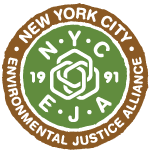
Extreme Heat & Air Quality
As climate change accelerates, a major impact is the increasing magnitude and frequency of extreme heat events; average summer temperatures are increasing while the length and severity of heatwaves are also increasing. NYC summers are getting hotter. According to the NYC Panel on Climate Change (NPCC), by the 2050’s, NYC can expect to see the number of 90-degree days double, and heatwaves could triple or quadruple. These rising temperatures pose serious health risks, particularly to frontline communities across NYC. The NYC Heat Vulnerability Index—an index that identifies neighborhoods with higher heat-related risks—shows that the most heat-vulnerable communities in NYC are predominantly composed of low-income residents of color.
At NYC-EJA, we are working to minimize the disproportionate negative effects of extreme heat on communities of color and reduce the urban heat island effect. To achieve this, our approach focuses on improving air quality and reducing co-pollutant emissions to address the compounding health impacts from extreme heat coupled with bad air quality. Additionally, we work to maximize “cooling” strategies, including expanding the urban forest, fighting for a maximum indoor temperature law, and advocating for increased access to resources such as the Home Energy Assistance Program. Most recently, NYC-EJA’s advocacy has led to the City Council passing Int 0998 (Cooling Center bill) in August 2025, a long-overdue bill that formally codifies and strengthens the City’s existing Cooling Center program.
Find our report on community heat and air quality monitoring below:
For a deeper dive describing the disproportionate impacts of extreme heat in NYC:
